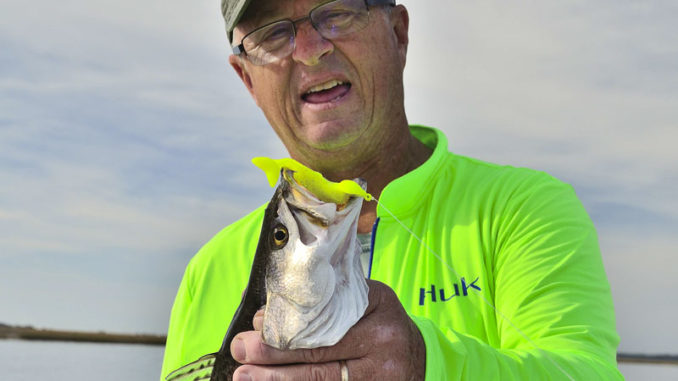
Fall rainfall can be a deciding factor on where you ought to fish in Carolina estuaries, especially if they’re fed by a river. Learn how and where to move when a storm arrives.
The long wait through the sweltering summer heat is finally over. Temperatures fall into a comfortable range, and fish such as speckled trout begin feeding like mad. The change of seasons in the fall is such a welcome event for residents of the Carolinas, who love cool, brisk mornings on the water.
Not only do anglers enjoy the cooler weather, so do the fish, especially speckled trout.
These fish move around, looking for optimal feeding opportunities in the fall, the way they do much of the year. Their waters are directly affected by river systems. So rainfall can have a drastic impact on where anglers need to cast their lures to bring home a limit of these tasty critters.
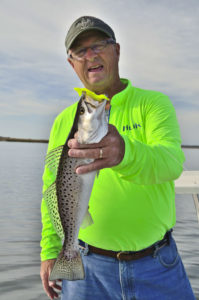
Most coastal estuaries along the Atlantic seaboard are not only fed by ocean water, but freshwater from rivers. Of the 17 river basins in North Carolina and eight in South Carolina, rainwater and natural springs fuel the water resources. Twenty of these rivers flow across the Carolinas and empty in to the Atlantic. As they approach saltwater, the landscape changes quickly and directly benefits the many creatures flourishing in these brackish and estuarine environments.
Rainfall impacts speckled trout patterns
Speckled trout are among the predators that champion these waters in the fall, making a dent in the shrimp and mullet populations. As these areas receive patterned or sporadic rainfall, their salinity can quickly change, especially along the freshwater-saltwater dividing line, and that can make a dramatic impact on where fall trout are found.
Brandon Huskins of Any Tide Fishing Charters fishes the Little River area along the North Carolina/South Carolina border. The Waccamaw River has a direct impact on the waters he fishes around the Little River area, because Little River is connected to the tannic Waccamaw system through the ICW. The level of rainfall in the area will directly impact the salinity and the location of bait and speckled trout in the estuary.
“Speckled trout are my favorite species to target in the fall, especially in October,” said Huskins (843-877-7068). “If you can find good conditions, you can find the fish. I prefer places with that copper-colored water.”
The water color says a lot about salinity of water
The tannins from the blackwater Waccamaw change the water in the Little River area to a stained, copper color. During periods of heavy rainfall, the dark waters infiltrate the saltwater estuaries, bringing freshwater into the picture. Water color is generally a good indicator of salinity in areas where estuaries are fed by tannic river systems.
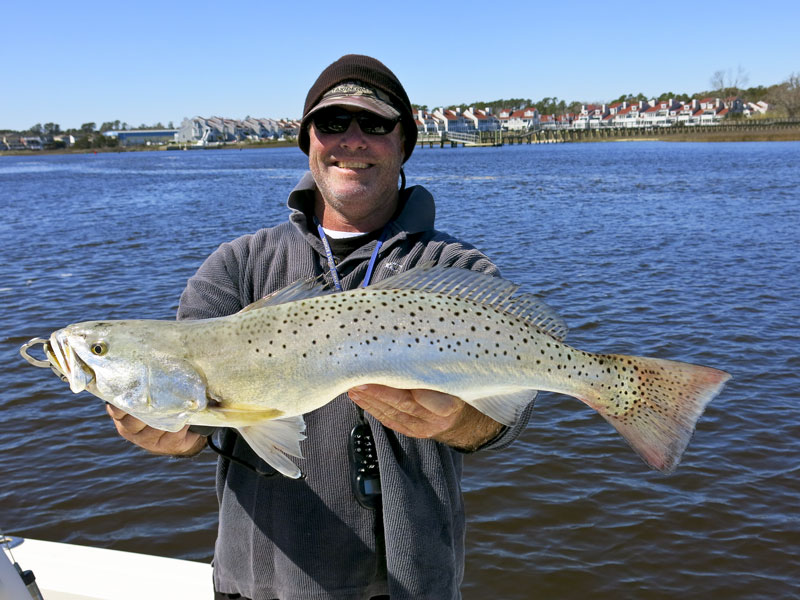
“The blacker the water is, the fresher water that is in it. You can also usually taste the difference,” he said.
While changes in salinity have little effect on some sea life, other saltwater creatures are influenced to changes in salinity.
“Shrimp are extremely sensitive to salinity content, and periods of heavy rain can push these shrimp schools down the waterway and closer to the inlets,” he said. “The large groups of schooling trout in the 15- to 18-inch range we see in the fall will be hanging close to these massive schools of shrimp.”
Extensive rainfall can push these trout into more salty places, as they follow the shrimp. But other forage species, including mullet and menhaden, will not move around as much when salinity changes, which will usually keep the larger, more-mature gator trout fat and happy.
Lack of rainfall moves speckled trout closer to freshwater
Conversely, lack of fall rainfall can push the saltwater wedge further up the waterway or further upstream into rivers.
Resident and migrating speckled trout are accustomed to venturing upstream in fall to take advantage of the conditions and feeding opportunities.
“Trout begin moving up the rivers in the fall because the water cools off first in the river, as opposed to the places near the ocean. Plus, bait is usually very abundant upstream,” he said.
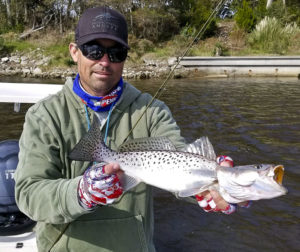
Little River’s upstream area is typically referred to as the ICW, basically a colossal ditch lined with docks, marinas and miles of mud flats littered with oysters and scattered grassy shorelines. Huskins fishes the waterway from the state line all the way south to beyond the Little River swing bridge.
The ICW’s layout takes away some of the mysteries, since there aren’t any fingers to venture up or points to target. But even in a natural river system with branches, points and larger tributaries, early fall trout will generally remain in the river’s main stem, stopping along points, creek mouths and places that concentrate baitfish in opportunity areas.
Find the right conditions, find the trout
Huskins is a major fan of fishing current seams and places that create ambush opportunities for trout in the fall months.
“When I target trout in the fall, the No. 1 combination I look for is a healthy current rip (and) clear, copper-colored water,” he said. “I seem to spend more time looking at the sky, the water and the weather than looking for the fish. But if you find the right conditions up the river, the trout will usually be there.”
Little River may be influenced by the tannic Waccamaw River, making it easy to recognize when freshwater is abundant. And these same tactics can apply to any river-fed estuarine system across the coast.
The tannic water may not always be there, but freshwater contributions are a given, and anglers can expect speckled trout to venture up the rivers when the water temperatures begin to fall. In some systems like the Neuse, Pamlico, Cape Fear and New rivers, the fall speckled trout run can push these fish many miles upstream and far away from the inlets and the mighty Atlantic.
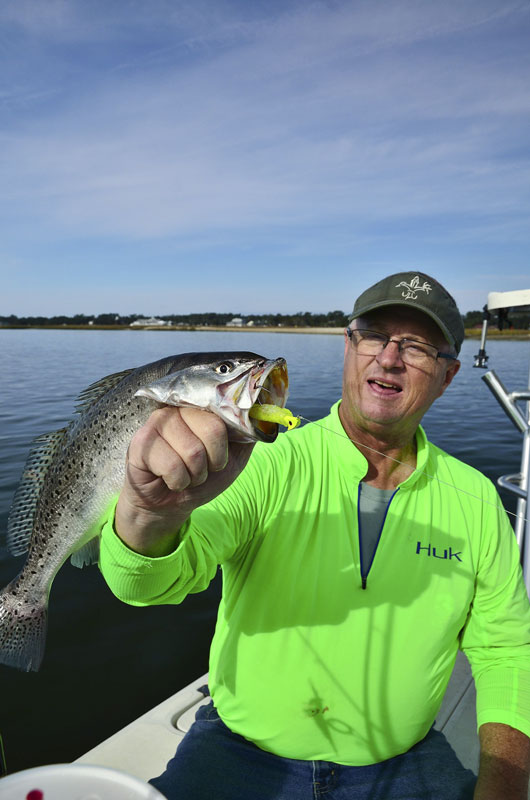
For big trout, lean toward baitfish imitations
Speckled trout feed on a variety of forage species throughout the year. While many trout and other fish eat pounds and pounds of shrimp, baitfish of all sizes end up inside their bellies on a consistent basis. Anglers need to be ready to present the right bait or lure to get the most out of a fishing trip.
Few speckled trout will ever turn down a live shrimp, which is why an artificial shrimp can produce strikes in most waters, but sometimes baitfish patterns may bring the bigger and better fish to the table.
Brandon Huskins of Any Tide Fishing Charters uses both live and artificial options throughout the year in his home waters of Little River along the North Carolina-South Carolina border, but he prefers to throw soft plastics in the fall. He believes lures imitating baitfish can be more productive than shrimp lures on larger fish up the rivers and near the freshwater-saltwater dividing line.
“For big trout, baitfish patterns are more productive on these bigger fish than shrimp patterns,” Huskins said. “Mature trout will eat shrimp like anything else, but these bigger fish want bigger baits. I like a lure that mimics a large finger mullet.”
Huskins uses swimbaits and paddletails like the 5-inch, Z-Man Diezel MinnowZ or Swimming Trout Trick — or a suspending or sinking hard bait like a MirrOlure 18MR or 52M.
Anglers will use both live bait and artificial lures to dupe trout throughout the year. A live shrimp under an adjustable float at the Little River Inlet jetties will surely attract the attention of a gator trout, but artificial lures that resemble a nice, juicy mullet can be the true solution to fooling a big trout lurking in the river water.





Be the first to comment